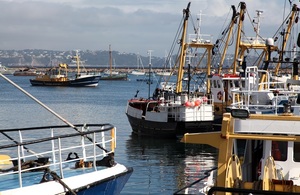UK agrees 2022 fishing catch limits with EU and Norway
All Parties agree to set catch levels in line with, or lower than, those advised by ICES in bid to champion sustainability and help protect fish stocks.

UK agrees fishing catch limits with EU and Norway for six jointly-managed fish stocks in the North Sea.
The UK has today (10 December 2021) reached agreement with Norway and the European Union on catch limits for 2022 for six jointly managed fish stocks in the North Sea.
The agreement signals the Parties’ continued commitment to the sustainable management of North Sea cod, haddock, plaice, whiting, herring and saithe to ensure the long-term viability of these stocks. The agreement has also established plans to review the distribution and management of shared stocks such as hake – a measure that aims to safeguard stocks which are important for the whole UK catching sector.
Negotiating as an independent coastal State, the UK has agreed catch levels for 2022 with Norway and the EU that provide fishing opportunities estimated to be worth around £190 million to the UK fishing industry, based on historic landing prices. This will provide certainty and stability for the industry ahead of the new year.
Fisheries Minister Victoria Prentis said:
I am pleased to announce we have concluded trilateral negotiations between the UK, EU and Norway.
We are proud to have led discussion to a positive conclusion as we seek to set a gold standard for the entire fishing industry.
We are confident that this agreement has struck a balance that will benefit both our fishing industry and ensure our marine environment is healthy and viable long into the future.
UK Government Minister for Scotland Malcolm Offord said:
As an independent coastal State the UK has agreed catch levels that provide opportunities estimated to be worth around £190 million to our fishing industry. I welcome the outcome of these negotiations as they provide certainty and stability for fishermen in Scotland and the rest of the UK while championing sustainability.
Throughout negotiations the UK, as chair, has advocated for stock management decisions based on the best science available to ensure sustainable agreements are made and stocks are protected for the interests of our industry and a healthy, viable marine environment.
Catch levels for five of the six stocks have been set in line with, or lower than, the level advised by scientists at the International Council for the Exploration of the Sea (ICES).
The catch levels agreed for 2022 (compared to 2021) are:
- Cod rollover
- Haddock +5%
- Herring +20%
- Plaice -12%
- Saithe -24%
- Whiting +25%
The UK Government has worked closely throughout the negotiations with the Scottish Government and other administrations to reach this consensus which seeks to benefit the entire UK fishing industry.
An assessment on the number of individual TACs set consistent with ICES advice will be published on the conclusion of the UK’s annual fisheries negotiations.
Additional information:
- This trilateral agreement marks the conclusion of one in a series of annual fisheries negotiations. The UK’s bilateral negotiations are underway, namely consultations with the Faroes Islands and Norway to agree quota and access arrangements for 2022, and consultations with the EU concerning TACs and management measures for the relevant stocks.
- This year the UK chaired the talks with rounds taking place in Edinburgh and London, maximising opportunities for face-to-face negotiations. Throughout the consultations the UK pressed for evidenced-based and pragmatic decisions to provide fishing opportunities whilst promoting the sustainability of stocks for the marine environment and industry.
- ICES produced a substantial increase in advice for a number of North Sea stocks, with haddock and whiting showing considerable expansion in their biomass. However, all Parties recognised that it would not be appropriate to take the full quota increase advised by scientists for these two stocks given their interactions with stocks like cod in the North Sea mixed fishery. Parties therefore agreed moderate increases in catches compared to 2021 to promote the health of all stocks in the fishery. The Parties have also agreed a catch level for North Sea herring below that recommended by ICES to deliver stability in the TAC.
- North Sea cod will be subject to the same tonnage limits as set for 2021. The agreed catch limit for 2022 is based on the published ICES advice, but is higher than that advice. This decision was based on the provisional landings data for the 2021 fishing year, which were not available when the advice was originally produced. This data suggests a realised fishing mortality in 2021 that is lower than that assumed for the published ICES advice. This catch level is predicted to allow the stock size to increase by a similar amount compared to following the published ICES headline advice. All parties will continue their individual management plans to protect the cod stock. The UK’s cod avoidance plan uses spatial measures and selective fishing gear to protect high abundances of cod and spawning grounds.
- The outcome of annual fisheries negotiations has been published in the Secretary of State determination of fishing opportunities for British fishing boats.